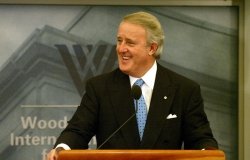Book Launch -- <i>Sandra Day O'Connor: How the First Woman on the Supreme Court Became Its Most Influential Justice</i>
Overview
When, in 1981, she was appointed to the United States Supreme Court, few people expected Sandra Day O'Connor to become its most influential justice. Drawing on the skills she had honed during a political career in Arizona, however, that is exactly the feat accomplished by the first woman to sit on the nation's highest tribunal.
Justice O'Connor's legacy as a politician, trailblazer and role model were the themes of the Division of U.S. Studies program held to launch Joan Biskupic's biography of her. Biskupic, who worked on her book while she was a Public Policy Scholar at the Center, described O'Connor as arriving at the Court "knowing how to count votes." O'Connor had demonstrated her political skills as an important volunteer for the Republican Party, an Arizona assistant attorney-general and majority leader of the Arizona Senate. Scholars of the Court in the 1980s tend to focus on the quiet power of Justice William Brennan, Biskupic remarked, pointing to his ability to achieve consensus. In fact, Brennan's influence waned as O'Connor's grew. When Brennan left the Court in 1990, his departure, along with the increasingly ideological divisions on the Court and in a politically polarized nation, made O'Connor the Court's most influential member. It was she who found the middle ground, taking an incremental approach to the law that enhanced her ability to persuade her colleagues to go along with her views. A painstaking, intense and efficient worker, she knew how to network, how to keep lines of communication open and how to deal with justices who were undecided about the way they would vote.
Both Richard Lazarus, who runs training sessions for lawyers about to appear before the Court and has argued many cases there himself, and Marcia Greenberger, whose organization has been a party in numerous cases heard by the Court, agreed with Biskupic that for the last 15 years, anyone appearing before the justices focused on O'Connor and the need to tailor arguments that would appeal to her. That meant not only seeking her vote, but fashioning much of a whole legal argument aimed not at the entire bench but at Justice O'Connor.
Lazarus, a former Center Fellow, warned that the measure of a justice's influence cannot be taken from examining votes alone. What is equally important is the maneuvering behind the scenes as justices try to secure each other's votes for the opinions they are writing, and it is there that O'Connor excelled. Part of the reason, Greenberger suggested, was that O'Connor concentrated on standards rather than rules. She was less interested in fashioning ironclad rules that would become the basis for decisions in future cases than she was in a highly specific, fact-based jurisprudence. For that reason, attorneys could never be quite sure how O'Connor would vote.
Greenberger discussed the way the first woman justice wrote for the Court creating a high standard in sex discrimination cases (Mississippi v. Hogan, 1982) and raising the standard of proof in sexual harassment cases (Jackson v. Birmingham Board of Education, 2005). Pointing to the seeming evolution of O'Connor's approach to abortion rights – after consistently voting to uphold state-imposed limitations on the right, she is credited with writing the plurality opinion in Planned Parenthood v. Casey (1992) that essentially affirmed it – Greenberger noted that recent polls showed the public eager to see the resigning O'Connor replaced by another woman. That, she suggested, was a testament to O'Connor's ability to break through glass ceilings.
O'Connor did not cooperate with Biskupic, saying that as a sitting justice she did not want to cooperate with any one author, but she did indicate that she had no objection to others doing so.
Biskupic was therefore able to interview seven of the other justices (Justice Souter declined), former O'Connor law clerks, and members of her family. Lazarus commented on the difficulty of writing a biography of a sitting justice, with the inevitable lack of historical perspective involved. One passage in the book, in fact, suggests the difficulty of assessing judicial capabilities without the benefit of hindsight. When O'Connor was nominated, as Lazarus read to the audience from Biskupic's book, The Nation commented that "in choosing Judge O'Connor, President Reagan has overridden some fundamental conservative principles and basic policy of his administration: for the highest Court in the land he has picked a person barely qualified for the post, almost entirely because of her sex and not on the basis of individual merit. Despite the many kind words of her friends, Judge O'Connor's record is not even close to Supreme Court quality. She was not an exceptional lawyer or legal scholar."
Philippa Strum, Director, Division of U.S. Studies 202-691-4147
Thank you for your interest in this event. Please send any feedback or questions to our Events staff.










